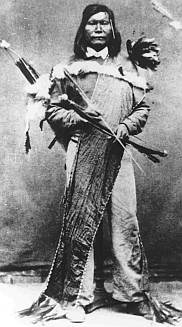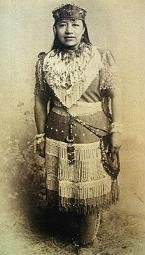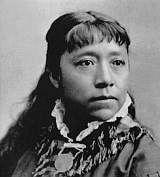Sarah Winnemucca facts for kids
Quick facts for kids
Sarah Winnemucca
|
|
|---|---|
 |
|
| Born |
Thocmentony ("Shell Flower"), also seen as Tocmetone
1844 near Humboldt Lake, Nevada
|
| Died | October 16, 1891 (aged 46–47) Henry's Lake, Idaho
|
| Nationality | Northern Paiute |
| Other names | Sarah Winnemuca Hopkins |
| Occupation | Author, educator |
| Known for | Activist and spokeswoman for Northern Paiute |
|
Notable work
|
Life Among the Paiutes: Their Wrongs and Claims (1884) |
| Spouse(s) | Edward Bartlett (1872) Lewis H. Hopkins (1881) |
| Parents |
|
| Relatives | Truckee (grandfather) |
Sarah Winnemucca Hopkins (born Thocmentony, meaning "Shell Flower"; also known as "Tocmetone" in the Northern Paiute language; around 1844 – October 17, 1891) was an important Northern Paiute woman. She was an author, an activist who gave speeches, and an educator who started schools. Her family name was Winnemucca.
Sarah Winnemucca was born near Humboldt Lake, Nevada. Her family was very important in the Paiute community. They wanted to have good relationships with the new settlers coming from Europe and America. Sarah was the daughter of Chief Winnemucca and the granddaughter of Chief Truckee.
When she was 16, Sarah went to a Catholic school in San Jose, California. Later, when the Paiute War started between the Pyramid Lake Paiute and the settlers, Sarah and her family went to San Francisco and Virginia City, Nevada to stay safe. They earned money by performing on stage as "A Paiute Royal Family." In 1865, while her family was away, their group was attacked by the US cavalry. Many Paiutes were killed, including Sarah's mother and other family members.
At 27, Sarah started working as an interpreter for the Bureau of Indian Affairs at Fort McDermitt in 1871. She became a strong voice for the rights of Native Americans. She traveled across the United States to tell people about the difficulties her people faced. When the Paiute were moved to a camp in Yakima, Washington after the Bannock War, she went to Washington, D.C. She asked the government to let her people go home. She also worked for the US forces as a messenger, interpreter, and guide. She even taught Native Americans who were held in camps.
In 1884, Winnemucca published her book, Life Among the Paiutes: Their Wrongs and Claims. This book tells her own story and the history of her people during their first 40 years with European Americans. It is known as the first autobiography written by a Native American woman. After her book came out, Winnemucca gave many lectures in the Eastern United States. She then returned West and started a private school for Native American children in Lovelock, Nevada.
Since the late 1900s, people have paid more attention to Sarah Winnemucca's achievements. In 1993, she was honored in the Nevada Writers Hall of Fame. In 2005, Nevada placed a statue of her in the National Statuary Hall Collection in the U.S. Capitol.
Sarah Winnemucca's story has some different views. Some people remember her mostly for her activism and work to help her people. Others have said she sometimes made her status among the Paiute seem bigger than it was. Some Paiute people have also questioned her help to the US military when they were fighting the Paiute. They also questioned her ideas about Native Americans adopting Anglo-American culture. Still, many Paiute people also recognize her important social work and her fight for indigenous rights.
Contents
Early Life and Learning
Sarah Winnemucca was born around 1844 near Humboldt Lake in what is now western Nevada. Her father was Winnemucca (Poito), and her mother was Tuboitonie. Sarah had an older sister, Mary, a younger brother, Natchez, and another sister, Elma. Her father was an important war chief for a group of about 150 Paiute people. The town of Winnemucca, Nevada is named after him.
Sarah first met white people when she was six. Her grandfather invited her to California. Her grandfather, Tru-ki-zo or Truckee, was known for having good relationships with the European Americans exploring the area. He even helped Captain John C. Frémont on his map-making trip across the Great Basin to California. Truckee also fought in the Mexican–American War, making many white friends. This helped his family have good relationships with European Americans.
When Sarah was six, she traveled with her family near Stockton, California. The adults worked with cattle there. In 1857, her grandfather arranged for Sarah (who was 13) and her sister Elma to live and work with William Ormsby and his wife in Carson City, Nevada. Mr. Ormsby owned a hotel and was a community leader. The Ormsbys wanted a friend for their daughter, Lizzie. Sarah and Elma also helped with housework. This gave them a chance to get better at English and learn more about European-American ways. Sarah became very good at moving between Paiute and European-American cultures. She was one of the few Paiute in Nevada who could read and write English. Her whole family also spoke English.
Pyramid Lake Conflict and Stage Shows
As more settlers came to the region for silver, Old Winnemucca arranged for his daughters to return to him in Nevada in 1859. In 1860, fighting began. The Paiute had killed two men who had kidnapped two Paiute girls. Settlers and miners formed a group, and Major Ormsby led them. He was killed by the Paiute in the first part of the Pyramid Lake War. The settlers were surprised by how well the Paiute fought. The Paiute and white settlers made a peace agreement by the end of that summer. Young Winnemucca, Sarah's cousin, became a war chief for the Paiute. In October 1860, her grandfather Truckee died from a tarantula bite.
Nevada became a US Territory, and James W. Nye was its first governor. He visited the Pyramid Lake Reservation and met Old Winnemucca, Young Winnemucca, and the Paiute people. For the next five years (1860–1865), Sarah and her family often left the reservation. They performed on stage in Virginia City, Nevada or San Francisco. They were called the "Paiute Royal Family." By this time, her father had a second, younger wife and a young son.
In Nevada, US forces often acted against Native Americans to show who was in charge. Native Americans were often accused of raiding and stealing cattle. In 1865, Captain Almond B. Wells led a group of Nevada Volunteer cavalry. They attacked Paiute groups across the northern part of the state without reason. While Sarah and her father were in Dayton, Nevada, Wells and his men attacked Old Winnemucca's camp. They killed 29 of the 30 people in that group.
The chief's two wives (including Sarah's mother) and infant son were killed. Sarah's sister Mary escaped but died later that winter because of the harsh conditions. Her younger sister Elma was not in the area. She had been adopted by a French family in Marysville, California. Elma Winnemucca later married a white man named John Smith and moved to a white community in Montana, and then Idaho.
In 1868, about 490 Paiute survivors moved to a military camp called Fort McDermitt on the Nevada–Oregon border. They sought protection from the US Army against the Nevada Volunteers. In 1872, the government created the Malheur Reservation in eastern Oregon for the Northern Paiute and Bannock peoples. Three Paiute groups moved there. In 1875, Sarah, her brother Natchez and his family, and their father Old Winnemucca also moved there.
Teaching and Interpreting
At 27, Sarah started working as an interpreter for the Bureau of Indian Affairs at Fort McDermitt in 1871. Indian Agent Samuel B. Parrish invited Winnemucca to be an interpreter at the Malheur Reservation. Sarah saw that Parrish worked well with the Paiute people. He helped them learn new ways and plant crops to support themselves. He also built a school at the reservation, and Sarah became an assistant teacher there.
Marriage and Family Life
Sarah married Edward Bartlett, a former Army officer, on January 29, 1872, in Salt Lake City, Utah. He left her, and she went back to Camp McDermitt. In 1876, after moving to Malheur Reservation, she got a divorce and asked to use her maiden name, Winnemucca, again. The court agreed. In her divorce papers, Sarah explained how she supported herself when her husband left her with no money. She wrote, "I did sewing. I made gloves for a living."
The Bannock War
After four years, Agent Samuel B. Parrish was replaced by William V. Rinehart in the summer of 1876. The Paiute were sad to see Parrish leave. Rinehart believed in harsh methods. He told the Paiute that the reservation land belonged to the government. He did not pay them for their farm work and upset many tribal leaders. Life at the Malheur Reservation quickly became very difficult.
In her 1883 book, Winnemucca wrote that Rinehart sold supplies meant for the Paiute people to white settlers. Much of the good land on the reservation was taken illegally by white settlers. In 1878, almost all the Paiute and Bannock people left the reservation because of these problems. The Bannock from southern Idaho had also left the Fort Hall Reservation for similar reasons. They moved west, raiding small white settlements in southern Oregon and northern Nevada. This started the Bannock War (1878). It is not fully clear how much the Northern Paiute people joined the Bannock. Winnemucca wrote that she and several other Paiute families were held by the Bannock during the war.
During the Bannock War, Winnemucca worked as a translator for General Oliver O. Howard of the U.S. Army. She had met him when he visited the reservation. She also worked as a scout and messenger. Winnemucca was highly respected by the officers she worked for. She included letters of recommendation from them in her 1883 book. She was impressed by many officers and began to believe the US Army should manage the Indian reservations instead of political leaders.
Moving to Yakama Reservation
After the Bannock War, the Northern Paiute groups were ordered to move from Nevada to the Yakama Indian Reservation in eastern Washington Territory. There, they faced many hardships. A total of 543 Paiute were held in a camp where they faced many challenges.
Winnemucca went with them to work as a translator. Since she had an official job, she did not have to live on the reservation. She was very upset by the difficult conditions the Paiute faced. She began to give speeches across California and Nevada about her people's struggles. In the winter of 1879 and 1880, she, her father, and two other Winnemucca family members visited Washington, D.C. They asked the government to release the Paiute from the Yakama Reservation. They got permission from the Secretary of the Interior, Carl Schurz, for the Paiute to return to Malheur, if they paid for it themselves. However, the government later decided to close the Malheur Reservation in 1879.
Second Marriage
In 1881, General Oliver O. Howard hired Sarah Winnemucca to teach Shoshone prisoners at Vancouver Barracks. While there, she met and became close to Lieutenant Lewis H. Hopkins, who worked for the Indian Department. They married that year in San Francisco.
Lectures and Writing
In 1883, Sarah and Lewis Hopkins traveled east. Sarah gave almost 300 lectures in major cities in the Northeast and Mid-Atlantic. She wanted to make people more aware of the unfair treatment against Native Americans. Newspapers reported her talks and often called her the "Paiute Princess."
In Boston, she met sisters Elizabeth Peabody and Mary Peabody Mann. They helped her speaking career. The two women also helped her put together her lecture materials for her book, Life Among the Piutes. Her book was published in 1883. It was the first known autobiography written by a Native American woman and the first US copyright registration secured by a Native American woman.
Sarah's husband helped her by gathering information for the book at the Library of Congress. However, he was sick with tuberculosis.
After returning to Nevada in 1884, Winnemucca spent a year giving lectures in San Francisco. When she returned to Pyramid Lake, she and her brother built a school for Indian children in Lovelock, Nevada. They wanted to teach about Paiute culture and language. The Peabody Indian School, named after their helper Mary Peabody Mann, ran for a few years. Changes in government policy, after the success of the Carlisle Indian School, led the government to support English-language boarding schools for Native American children. Winnemucca's school closed in 1887, and the children were moved to a school in Grand Junction, Colorado. Even with money left to her by Mary Peabody Mann and efforts to make the school a training center, Winnemucca was having money problems when her husband died in 1887.
The Dawes Severalty Act of 1887 required that shared lands on reservations be divided among individual families. This was done to try and make tribes adopt American culture.
Winnemucca spent the last four years of her life away from public work. She died of tuberculosis at her sister Elma Smith's home at Henry's Lake, Idaho.
Legacy and Honors
- Anthropologist Omer C. Stewart said Winnemucca's book about the Paiute is "one of the first and one of the most enduring ethnohistorical books written by an American Indian." Scholars have often used it throughout the 1900s.
- In 1993, Sarah Winnemucca was added to the Nevada Writers Hall of Fame.
- In 1994, an elementary school in Washoe County, Nevada was named after her.
- In 1994, Sarah Winnemucca was added to the National Women's Hall of Fame.
- In 2005, the state of Nevada gave a statue of Winnemucca to the National Statuary Hall Collection in the U.S. Capitol.
Works
- Life Among the Paiutes: Their Wrongs and Claims (1884) (new edition in 1994)
- 1886 pamphlet, "Sarah Winnemucca's Practical Solution to the Indian Problem"
See Also
 In Spanish: Sarah Winnemuca para niños
In Spanish: Sarah Winnemuca para niños




